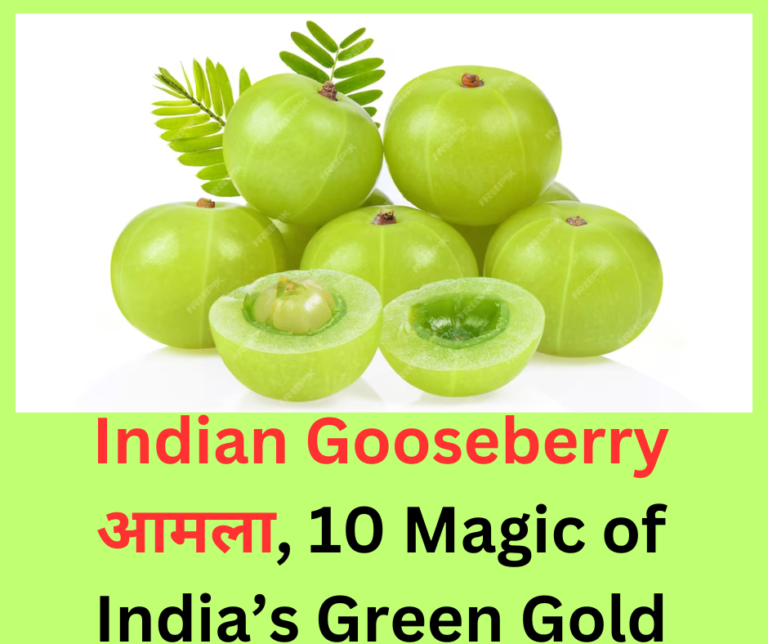Table of Contents
Indian Gooseberry: A Tangy Treasure of Health and Tradition
Indian Gooseberry, also known as Amla, holds a special place in the rich tapestry of Indian culture and holistic health practices. From its nutritional benefits to culinary uses, this small green fruit is a powerhouse of goodness. In this article, we will delve into the various aspects of India Gooseberry, exploring its historical significance, nutritional value, health benefits, culinary uses, cultivation methods, and much more.
I. Introduction
A. Definition of Indian Gooseberry आमला
Indian Gooseberry, scientifically known as Phyllanthus emblica, is a small, round fruit native to the Indian subcontinent. Its vibrant green color and distinctive sour taste make it a unique addition to various dishes.
B. Historical Significance
Amla has been an integral part of traditional medicine in India for centuries. Its mention in ancient Ayurvedic texts highlights its medicinal properties and cultural importance.
II. Nutritional Value of Indian Gooseberry आमला
A. Rich in Vitamin C
One of the standout features of Indian Gooseberry is its exceptionally high vitamin C content. This antioxidant plays a crucial role in boosting the immune system and promoting overall well-being.
B. Other Essential Nutrients
Beyond vitamin C, Amla is a rich source of antioxidants, fiber, and various vitamins and minerals. These elements contribute to its multifaceted health benefits.
III. Health Benefits Indian Gooseberry आमला
A. Boosts Immunity
Regular consumption of Indian Gooseberry is linked to enhanced immune function, helping the body ward off infections and illnesses.
B. Aids in Digestion
The fiber content in Amla supports digestive health, preventing constipation and promoting a healthy gut.
C. Promotes Hair Health
Amla is a popular ingredient in hair care products due to its ability to strengthen hair follicles and promote hair growth.
IV. Culinary Uses
A. Traditional Recipes
Amla is a versatile ingredient in Indian cuisine, featured in chutneys, pickles, and sweets. Its tangy flavor adds a distinctive touch to various dishes.
B. Modern Culinary Trends
In recent years, Indian Gooseberry has gained popularity beyond traditional recipes, finding its way into smoothies, salads, and even cocktails.
V. Growing India Gooseberry
A. Climate and Soil Requirements
Indian Gooseberry thrives in subtropical climates and well-drained soil. Understanding its growth requirements is essential for successful cultivation.
B. Cultivation Process
From planting to harvesting, a step-by-step guide to cultivating Amla ensures a bountiful yield and sustainable practices.
VI. Ayurvedic Perspective
A. Medicinal Properties
Ayurveda recognizes Amla for its rejuvenating properties, contributing to the balance of bodily doshas.
B. Traditional Uses in Ayurveda
Ancient Ayurvedic texts prescribe various formulations containing Amla for treating a range of ailments.
VII. Global Popularity
A. Increasing Demand in International Markets
The global demand for Indian Gooseberry has risen, with consumers recognizing its health benefits and unique taste.
B. Popular Products Derived from Indian Gooseberry
Beyond fresh fruit, Amla extracts and supplements are gaining popularity in the health and wellness industry.
VIII. Conservation Efforts
A. Sustainable Harvesting Practices
As the popularity of Indian Gooseberry grows, efforts to ensure sustainable harvesting practices become crucial to preserve this valuable resource.
B. Importance of Preserving India Gooseberry
Understanding the ecological significance of Amla emphasizes the need for conservation to maintain biodiversity.
IX. Myths and Facts
A. Common Misconceptions
Dispelling myths surrounding Indian Gooseberry helps consumers make informed choices about its consumption.
B. Dispelling Myths with Scientific Evidence
Scientific research provides evidence to debunk common misconceptions, fostering a clearer understanding of Amla.
X. Side Effects and Precautions
A. Allergies and Contraindications
While generally safe, some individuals may experience allergies or adverse reactions to Amla.
B. Safe Consumption Guidelines
Guidelines on the safe consumption of India Gooseberry ensure that individuals can enjoy its benefits without risks.
XI. Indian Gooseberry in Beauty Products
A. Presence in Skincare and Haircare Products
The beauty industry recognizes the benefits of Amla, incorporating it into various skincare and haircare formulations.
B. Benefits for Skin and Hair
A closer look at how Indian Gooseberry contributes to healthy skin and lustrous hair in beauty products.
XII. Research and Studies
A. Recent Scientific Findings
Ongoing research continues to unveil new aspects of Indian Gooseberry, contributing to its growing reputation as a superfood.
B. Ongoing Research on India Gooseberry
An exploration of the latest studies and ongoing research projects focused on understanding the full potential of Amla.
XIII. Recipes and DIYs
A. Delicious Recipes Incorporating Indian Gooseberry
Explore creative and tasty recipes that showcase the versatility of Amla in the kitchen.
B. Homemade Beauty Treatments
Simple and effective DIY beauty treatments using Indian Gooseberry for glowing skin and healthy hair.
XIV. Consumer Tips
A. How to Choose Quality Indian Gooseberry Products
Tips for consumers to identify and select high-quality Amla products for maximum health benefits.
B. Storage and Usage Tips
Proper storage and usage guidelines to ensure the longevity and effectiveness of India Gooseberry products
You Also like to read – 5 Home Remedies for Soar Throat



